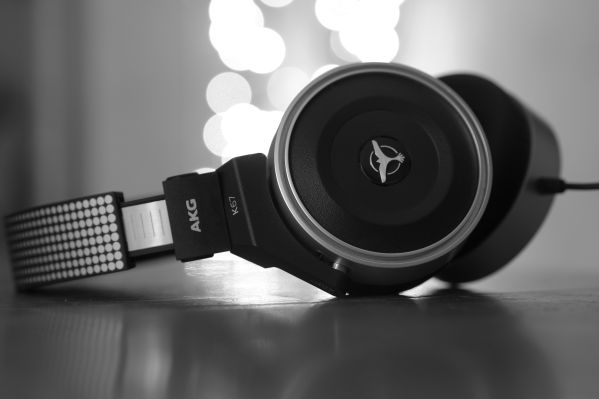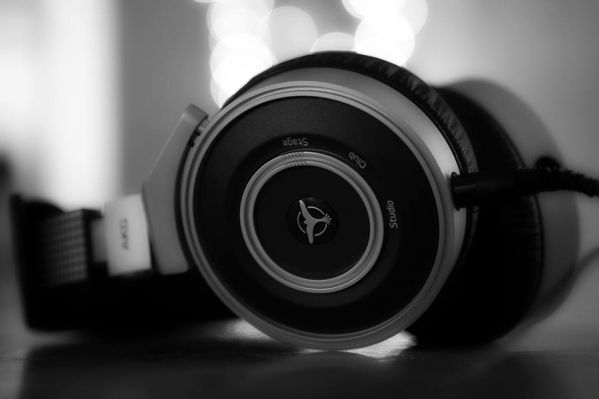The K-267.
Why isn’t this set making bigger news with Audio nuts like myself? This headphone put my Momentum and M100 to SHAME in terms of enjoyment and musicality. The sonic imaging on this headphone is second to none in the sub $300 price range for closed backs. Nothing even came close to the overall gorgeous presentation itself. Sure, there are wider stereo imaging sets like the Denon D-2000s and maybe even the V-Moda M100, but all of them pale in comparison to the presentation itself as a whole. This set is nothing short of beautiful.
The lows on this headphone differ depending on which switch you select on each earcup. Offering three different settings: Studio, Club and Stage. The experience is measurably different and very audible. It’s a bass booster that actually works and remains in control and smooth throughout. You can freely switch between each earcups three optional dial settings, the sound difference is very apparent and it makes me smile each time I can hear the difference.
The Studio setting is the more balanced of the three, offering a very soft and forgiving, yet weighty bass experience. It’s simply gorgeous and I think the bass quality on this headphone far outshines anything prior from AKG in that price tier. The A/B comparison with my K-550 resulted in a more pure but lacking bass experience on the K-550, but so much softer and more responsive on the K-267.
I never use the middle setting called Club, it seems a bit out of place and needless. A minor hike in bass that isn’t so audible in quantity over the differences between Studio to Stage. It still remains clear and tonally smooth. The Stage setting is where the fun begins. This could be the best overall live bass boost function on a headphone without software needed that I’ve ever heard. It is meant for actual DJ’s at a club or live on stage, where the low end really gets lost through closed back headphones due to the reverb effect in large areas. The extra push really helps out in loud venues, yet the control factor here is pretty good.
Beyond this, the headphone itself is capable of being a bass head headphone with proper DSP usage in Foobar2000. Bass Heads pay attention, you can toggle that bass up a hefty amount and keep a solid and seriously weighty experience before getting wacky. The M-100 and Momemtum fall off the ship far before the K-267’s do with regard to EQ on the low end.
DSP Explained: Foobar2000 has a free addon called Real Bass Exciter, which is an alternative low end EQ function. It is much more clear and offers more control over the stock functions the software offers. On a flat EQ setting with this DSP active as well, the K267 can gain up to +10 and still sound smooth, where as the Momentum, DT1350, HD25-II, M1 and M100 end up sounding warped and overly shaky nearer to +6. Beyond that, especially with the Vmoda M100, the experience is gack ugly on most of these other headphones, yet remains nice and enjoyable with the K267.
This K-267 has bar none, the best mid range I’ve ever heard in a portable headphone in recent times. I got a chance to hear the ATH-ES11 recently and by comparison I would still pick the K-267 over it. Now, the downside for me is that I prefer my midrange to be less studio monitor like and more like Audeze or JHaudio. AKG doesn’t really offer any headphone mid ranges in terms of tonality-coloration ( the flavor ) that I go crazy for. But, the clarity is good despite that, AKG’s house sound just isn’t my style or preference with regard to the midrange. That means nothing and you should consider that highly subjective and only my personal preference on the matter.
The mids are beautiful and gentle. Nothing else needs to be said, they have no nasalness or bite to them and remain soft, focused, very forward and intimate all while maintaining the overall best sense of effortlessness and air in the stereo void for the price range that I’ve ever heard. Now, prior to this I thought my Fidelio L1 by Philips had the best mid range presentation and closely followed by the AKG K-550…nah, The K-267 are more enjoyable for me. Both of those headphones I mentioned have more bite and more slam to the vocals, where the K-267 remains tonally softer. This sound is unique. I cannot think of any other headphone that offers a very forward and intimate sound but also is soft and relaxed in a physical sense.
The highs have a massive drop off, but despite that they remain enjoyable. It is not the headphone you want to do master control editing with, but it is the headphone you’d want to listen to the final product with. It is anti-sibilant and non fatiguing, which again is the general setup for the series. They have a hint of brightness to them but lack bite and authority. I find them immensely enjoyable for fusion guitar and violins. Far from accurate, but highly enjoyable despite that.
The stereo image lacks width, but due to the highly forward and intimate sound, you really don’t notice. If you are into the width thing, skip this. If you want the more intimate and close to the artist feel, you should try to demo this headphone as soon as possible.
For $225 used or so down from an original $449 MSRP, this headphone is beyond stellar. General height in the stereo void is excellent but the overall sense of sound stage is much smaller than say my Denon D-7000 for example. It is also not as deep, but it is more effortless. The headphone lacks physical definition, instruments and vocalists sound rounded and appearing out of the void of the stereo image without defined edges: The edges are rounded, so to speak. Another odd thing I’ve found about this model is that it doesn’t scale up much.
I enjoy the experience equally on my iBasso DX50 portable dap as I do with my $50 Sansa Fuze with Rockbox. The headphone doesn’t really require much to sound nice and still sounds very good on the Sansa Clip Zip and iPods. This is a great thing, its one of the few mid tiers that sounds great with shoulder shrug worthy sources. Via my Burson Conductor SL, the experience is highly intimate and the only thing that really improved was the bass quality and the treble. That midrange remained the same on the DX50 to the Fuze and back to the Burson.
Gripes:
I wish the K-267 had much nicer earpads and a portable length cable. Despite that awesome mini XLR type input on the cable, I’d still prefer a standard and smaller 2.5mm or 3.5mm to keep it as low profile as possible. The headphone doesn’t need to fold, the earcups are too large for it and the angle of approach when it folds will scratch the earcups evntually. It is going to happen, they touch each other as soon as they fold inward. I’d rather have a traditional folding experience on that, instead of the odd “wrapping one side underneath the other” style. But that is not at all important and just minor gripes I have.
Click next page for some final words…



